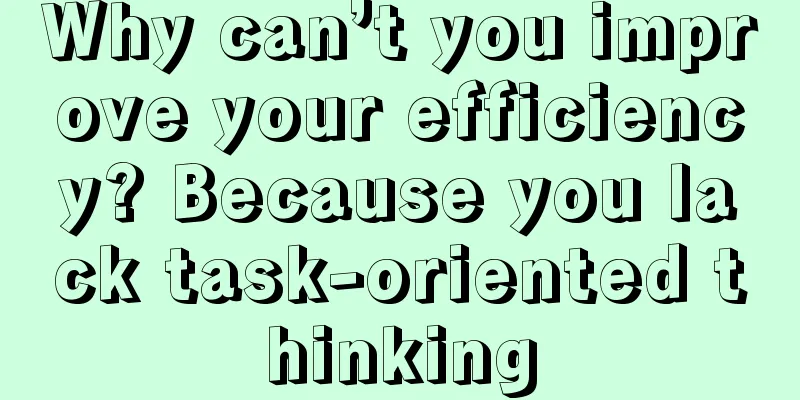Why can’t you improve your efficiency? Because you lack task-oriented thinking

Many people ask me how to be efficient? There is only one secret: task thinking. When it comes to it, people have different understandings. In a narrow sense, task thinking is a way of thinking when facing a task. Under this understanding, the focus is on how to complete it, just like only pursuing a passing score. 60 points are enough, and more than one point is a waste of resources. The task thinking I understand is a proactive thinking mode. It is a process in which "I" actively issues instructions to the brain without any external requirements, emphasizing the process of constantly driving oneself to a certain goal and seeking solutions. 01Why rely on task thinking? Because the brain is unreliable. Let’s take a simple example: one day, you suddenly see a short video, and the blogger’s impressive figure inspires you, so you vow to start working out the next day. If you don’t have a specific action plan, the impulse to do what you want to do will soon disappear. Even if you remember it the next day, you will feel confused and don’t know where to start. I often encounter this situation. When reading, a topic of the author suddenly brings inspiration, but if I don’t open the memo and write it down immediately, this idea will be thrown out of my mind in an instant. In order to change my old habit of “not liking to take notes at all times” and establish new habits, I consulted a lot of scientific literature on brain efficiency and discovered two secrets. 1. Thinking has nothing to do with the brainProfessor Chris Frith, a neuropsychologist at the University of London, has an interesting point of view. He said that the brain often processes information unconsciously, and the world we feel, including our personal feelings, are illusions created by the brain. Frith believes that even minimal brain activity can shape our personality and our understanding of the world. Because the brain has a strong ability to understand information, even if it is given very little information, it can create rich understanding and knowledge. If the brain is too active, it will make the understanding confused, and in the end, nothing can be understood. For example, sometimes you think too much, but the more you think, the more confused you become. This research was published on the official website of Nankai University, and he also wrote a book for it called "Creating Consciousness: How the Brain Creates Our Spiritual World." In the past, people believed that the more information the brain received, the stronger the thinking ability. In fact, this is not the case. Real high-level thinking does not depend on how much information the brain receives, but on being good at organizing models and organizing the framework for solving problems. A more intuitive analogy is: the brain is like a piece of land, and the ability to think is like the various trees growing on the land. These trees are like the different models we use to think and solve problems. Each tree has its own characteristics, which determine the way it handles problems. Trees absorb nutrients from the soil to grow, and similarly, our thinking patterns also obtain information and knowledge from the brain. It is a bit like training ChatGPT, giving it different information and knowledge, and it will use these to form answers and solve problems. So, doing something well has nothing to do with the brain; it is the thinking model that determines it. 2. Thinking is automatic narrativeWhat is automatic narrative? It is something that has become so routine that we can do it naturally without even thinking about it. It is something that is formed gradually based on previous experience and habits, and then becomes automatic in the brain. Rational narrative relies heavily on a key part of the brain, the prefrontal region. What role does it play? Two aspects:
Whether it's making plans, controlling attention, or expressing emotions in social situations, it has the final say; at the same time, it will filter and temporarily store the information it sees in front of it so that the task can be carried out. This is troublesome. Why? Imagine that the frontal lobe is like a theater stage. Every day and every hour, all kinds of information must be displayed here, and the workload is quite large. Therefore, it will use the principle of priority to deal with things, and the most important things will be ranked by default. What you think is rational and independent thinking has actually been arranged in advance. For example, when you consider whether to buy breakfast in the morning, your brain has already evaluated whether you have time and whether you will be late. So, on the surface, you are weighing the choice of buying breakfast, but in fact, your brain has already considered more important things for you. 02You can think of the finite framework as "rules." It guides the general direction. In the morning, the alarm clock rings, you get up, wash, eat breakfast, and then go out to work. The whole process is a manifestation of an orderly framework. You don't need to decide every morning whether to get up or brush your teeth. These decisions have been fixed and become part of your daily life. There is a similar narrative framework at work. Going to the company to handle emails, attend meetings, complete daily tasks, and who to contact for daily tasks, these do not require a lot of thinking, they have become habits. What are its benefits? The most direct manifestation is that life and work are easier and more efficient. Imagine this: an experienced UP host has honed a fixed workflow, including how to conceive themes, shoot, edit, and publish videos, and each step is in order. This fixed process makes video production almost automatic, greatly reducing the workload. Even if a certain link needs to be fine-tuned, it can be easily handled, and this has become a habit. The same goes for you. If you are a project manager preparing for a large meeting, and you are used to using Feishu and DingTalk to manage cross-departmental work, such a habit can naturally help you improve efficiency. Similar examples can also be found in life. Many families have their own set of rules. For example, the family stipulates that they will do a big cleaning on Monday, buy meat for the week on Tuesday, and cook at home instead of ordering takeout on Wednesday night. Everyone knows what to do and performs their duties. This lifestyle habit makes things at home more organized. 03Narratives within a limited framework also have obvious disadvantages. The most direct manifestation (in behavior and thinking) is path dependence. Why? Think about it, when we first learned to drive. At that time, we strictly followed the instructor's instructions, such as how to change gears, how to control speed, and when to use the turn signal. The driving habits we learned at the beginning became the default driving method over time. Over time, we will overly rely on these driving habits when we first learned to drive. For example, if you are good at shooting videos, and one day you are asked to switch to graphic design, that is a completely different matter. Although videos and graphics look similar, the workflow and way of thinking are completely different. At this time, you have to rebuild a new working model. The so-called path dependence is a process of getting smoother and smoother. At first, you may stumble upon a good way to solve a problem, which works well, and you use it more and more. As you use it more and more, you will naturally become more familiar with it, and it will become more and more effective. But the problem is that this approach will strengthen your narrative structure. Once this pattern is formed, it is very difficult to change it. For example, in the narrative structure of going to work, most people take the subway for an hour. Some people are used to reading novels, some people scroll through their information flow, and some people listen to music and play games. In the narrative structure of returning home at night, some people simply wash up and go to bed, while others wash their face, brush their teeth, apply a facial mask and drink a glass of milk. Nothing can be missed. You tend to allocate your energy to the things you are best at and the things you find easiest. Even if you encounter a better way in the future, you will be reluctant to try new changes because you have become accustomed to the original method. My deep understanding of it comes from my reflection on "writing". After five years of reading countless efficient writing methods, I finally realized that the real problem is not the method itself. In the past, I only considered writing when I really sat down and prepared to write. In other words, writing is not a regular part of my other daily narratives, and it has nothing to do with them. So how can I expect to improve my writing efficiency only at a specific time and in a fixed way? After careful consideration, I found that these fixed narrative structures are almost everywhere. For example, every time we want to lose weight, we just talk about it. This narrative structure of "talking but not doing" has been affecting us ; in fragmented time, we unconsciously browse our phones. This narrative structure of "browsing as soon as we open it" has become a deep-rooted habit. Interestingly, in the past, a friend in our department liked to bring his phone with him when he went to the toilet. He would stay in the toilet for a short time without his phone, but once he brought his phone, he would stay there for half an hour. This is also a narrative structure, a way to use leisure time. There are even more serious ones. Some people like to buy crazily in the live broadcast room, and buy as soon as they see a bargain. This narrative structure of crazy buying makes you fall into unnecessary consumption. Everyone has different narrative structures in their own path dependence. There is nothing wrong with it. It makes you feel comfortable, reduces decision-making costs, and does not affect work and life, so you will continue to do it. 04My intuitive feeling is that narrative structure brings a positive constraint. Usually when we talk about comfort zone, we mean the psychological state of avoiding changes or challenges in order to maintain psychological safety. This state is related to laziness and unwillingness to make progress. For example, some of my friends are afraid of losing their jobs, so they would rather stay in a job with no development and they are not used to, rather than take the risk of looking for new opportunities. In the narrative formed under path dependence, the meaning of comfort zone is somewhat different. Here, comfort is a positive state that comes from our expertise and proficiency in a specific field. Similarly, at work, if you are particularly good at operations, your boss is more likely to let you be responsible for this area of work. I have seen many people with strong professional skills feel confused in this narrative framework. I have a friend who is a product manager. He recently lost his job and came to ask me how to start a side business. I suggested that he use the product thinking he has accumulated over the years to do something. For example: open an account, run a paid column, write documents or operating manuals, etc. As long as these things can be sold, it can at least be considered a small business. His answer surprised me a little. He said that he usually looks at data and does AB testing at work, and he feels that these skills have no direct connection with the side job he understands. You see, a person's thinking and action mode within a specific work scope will form a unique positive narrative method. This kind of narrative is good in a company , it makes you more professional. You may be able to write operating manuals and documents at the beginning, but if you switch to something new, you won’t know where to start. Narrative structure limits development. In other words, dependence on inherent narrative structure in thinking and behavior will hinder you from exploring more possibilities. It is not a question of empathy, but a narrative way of thinking that has been stereotyped to some extent. Similarly, I found that people around me who do well in graphic work often find it difficult to transform into the field of short videos. One of the main reasons is that they are too accustomed to using graphic thinking to do things. Therefore, it is very difficult to change the thinking narrative cultivated by past successful experiences. It is like saying that you not only have to jump out of the existing narrative framework, but also change your thinking and behavior habits, which is much more difficult than simply getting a person out of his comfort zone. 05I can relate to this topic. In fact, I once faced similar challenges and found three ways to change: 1. Give instructionsEveryone can give instructions. "I want to lose weight tomorrow" is an instruction. The problem is, how to give an instruction that can be executed is very important. It is important to understand that the old thinking patterns are deeply rooted in our lives. They bring us immediate satisfaction and comfort. You used to give instructions and forget about them the next day, and it has become a habit. To change these thoughts, you must rely on perseverance at the beginning, there is no other way. When I want to do something completely new, I will push the method from the bottom of my heart, constantly reminding myself that I must do it and take action. Only by repeating the idea continuously will the brain receive the signal "I want to do something"; however, the signal is weak at the beginning, and it will feel that it cannot be completed. At this time, I will encourage the brain, "I can do it." This is a prerequisite for changing the subconscious mind, changing it from receiving signals and feeling that it can't do it to accepting signals and feeling that it can give it a try. The purpose of doing this is to make it easier for the body and mind to follow the guidance of the subconscious mind and avoid giving up halfway. 2. Change the narrative frameThe principle of small steps in action is to break things down into small steps to complete them. The action I mentioned, though simple, is not easy to implement. It consists of three small steps: remember, disassemble, and act. Note. For example, when I read a blogger's content and am inspired by a certain point of view, I will immediately open the memo and write it down. The content can be a sentence or a paragraph. This is a principle of anytime. In the previous narrative of each stage, there was no such habit. Break down. Break down means to break down the steps. It is similar to reading a book. You need to break it down into several small steps to execute, such as reading a part today and another part tomorrow. Finally, do it. The most difficult part is to do it. Why? Our overall narrative framework during the day is fixed. You have to go to work at a certain time, get off work at a certain time, and do what you do. It is difficult to change. What can we do? We can only manually intervene in the specific narrative structure and content of each paragraph. Intervention means quantifying what you want to do into a "specific time period". For example, if you want to become a video blogger, you used to browse the information flow while taking the subway. Now, you can try to watch some related content during this time. 3. Continuous trainingThe difficulty for many people is that they are stuck in the old thinking mode, for example, they think that only sitting in front of the computer and concentrating can complete a certain task. In fact, there are many narrative structures around us that can be fully utilized. If you want to write a script or find inspiration, you can be inspired while walking on the road, squatting on the toilet, or chatting with friends; when making a project report, you don’t have to sit in front of the computer to come up with a framework. You can multi-thread many things you want to do. To change this pattern, you need continuous training. If you can stick to it for half a month, you will find that your original narrative structure has changed. This change occurs not only at the action level, but also at the thinking level. In addition, remember that thinking is inert. When encountering new problems, you should not always think of using old methods to solve them. To cultivate new thinking, you have to install a new way of thinking in your brain, just like installing a new program for artificial intelligence. It's like going to work in a company. If you don't take this road, you can get there by another way. Give instructions, change the narrative framework, and continue training. In half a month, you will be able to escape from the original positive narrative, and your neural structure will also be rewritten. Give it a try. In summary, it is not the brain that counts, but the task. People often say that whether you can be efficient depends on your degree of relaxation. In my opinion, if one thing repeatedly stops you, it is most likely that the narrative structure is wrong. Cognitive resources are distributed, and so are tasks. If you want to challenge something completely new, just disassemble it, and after disassembling it, put it into a multi-time narrative framework. The advantage is that you don’t have to rely entirely on the brain’s concentration, and it can also improve overall efficiency. Author: Wang Zhiyuan WeChat public account: Wang Zhiyuan (ID: Z201440) |
<<: Skits are booming, but why is no one around us watching them?
>>: Brands are closing down one after another, what is the way out? Save these 9 suggestions!
Recommend
What is the process of transferring an etsy store? Precautions
If you want to sell something on the Etsy platform...
Uncovering the phenomenon of live treasure appraisal on Douyin: the craze for cultural and artistic jewelry behind the entertainment
Recently, the treasure appraisal live broadcast on...
As the Games get underway, brands are also competing in Olympic advertising
The Olympics is not only a feast of sports competi...
Instant Retail Era: “Deterministic Increment” of Consumer Electronics
In the era of instant retail, consumer electronics...
How to pay taxes when operating a shoppe? How much does the platform charge?
Nowadays, in addition to considering issues such a...
Is there a time limit for companies to settle foreign exchange? How often should they settle foreign exchange?
Foreign exchange settlement by enterprises refers ...
What value does branding have for a business?
This article talks about the value that brands can...
Why did Shopee not receive any orders for a month? What are the reasons?
Every merchant who opens a store online hopes that...
Does Amazon Europe need VAT for self-delivery? Under what circumstances do I need to register for VAT?
If you want to open a store on Amazon Europe, you ...
What is the Amazon brand authorization process? What are the benefits of Amazon brand authorization?
Merchants need to abide by the rules when opening ...
What is Operations?
This article analyzes the four stages of operation...
What level of thinking ability is you at?
This article introduces the four levels of thinkin...
Jiugongge live broadcast makes people rich: "Big Brother" spends tens of millions on rewards, and the anchor earns 200,000 yuan a month
Jiugongge Live has recently launched a low thresho...
How can I place an order by following others’ sales on Amazon? What are the techniques for following others’ sales?
Now more and more merchants are opening stores on ...
Don’t just compare year-on-year and year-on-year. These five steps will make your data analysis more in-depth.
How to deepen the data analysis project? From what...









